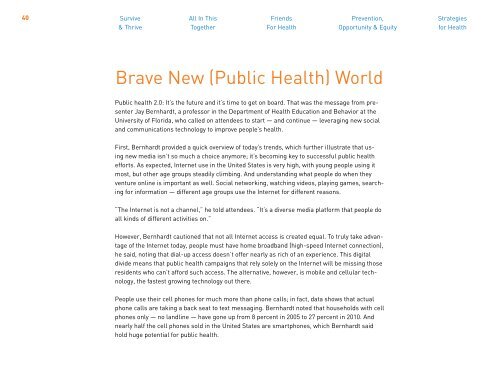INSIGHT & INSPIRATION FROM APHA’S 2012 MIDYEAR MEETING
INSIGHT & INSPIRATION FROM APHA’S 2012 MIDYEAR MEETING
INSIGHT & INSPIRATION FROM APHA’S 2012 MIDYEAR MEETING
You also want an ePaper? Increase the reach of your titles
YUMPU automatically turns print PDFs into web optimized ePapers that Google loves.
40<br />
Survive All In This Friends Prevention, Strategies<br />
& Thrive Together For Health Opportunity & Equity for Health<br />
Brave New (Public Health) World<br />
Public health 2.0: It’s the future and it’s time to get on board. That was the message from presenter<br />
Jay Bernhardt, a professor in the Department of Health Education and Behavior at the<br />
University of Florida, who called on attendees to start — and continue — leveraging new social<br />
and communications technology to improve people’s health.<br />
First, Bernhardt provided a quick overview of today’s trends, which further illustrate that using<br />
new media isn’t so much a choice anymore; it’s becoming key to successful public health<br />
efforts. As expected, Internet use in the United States is very high, with young people using it<br />
most, but other age groups steadily climbing. And understanding what people do when they<br />
venture online is important as well. Social networking, watching videos, playing games, searching<br />
for information — different age groups use the Internet for different reasons.<br />
“The Internet is not a channel,” he told attendees. “It’s a diverse media platform that people do<br />
all kinds of different activities on.”<br />
However, Bernhardt cautioned that not all Internet access is created equal. To truly take advantage<br />
of the Internet today, people must have home broadband (high-speed Internet connection),<br />
he said, noting that dial-up access doesn’t offer nearly as rich of an experience. This digital<br />
divide means that public health campaigns that rely solely on the Internet will be missing those<br />
residents who can’t afford such access. The alternative, however, is mobile and cellular technology,<br />
the fastest growing technology out there.<br />
People use their cell phones for much more than phone calls; in fact, data shows that actual<br />
phone calls are taking a back seat to text messaging. Bernhardt noted that households with cell<br />
phones only — no landline — have gone up from 8 percent in 2005 to 27 percent in 2010. And<br />
nearly half the cell phones sold in the United States are smartphones, which Bernhardt said<br />
hold huge potential for public health.



